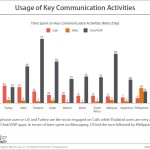Sharing Sensitive Data without Losing Control
Sharing data is not only the reality of modern working life but also a necessity for all businesses, whether that’s sharing data internally or with external partners and suppliers. Of course, this sharing of data brings with it the risk of losing control over who has access to it. To better understand the risks of sharing sensitive data, and how the right tools can help you minimise these risks, here are some key considerations from Gospel Technology, who have created a secure database that is tailor-made for sharing sensitive data while retaining control.
Common Risks When Sharing Sensitive Data
Some of the most commons risks of sharing sensitive data are human error and carelessness. A simple mistake such as entering the wrong email address can lead to sensitive information falling into the wrong hands, causing an unnecessary set of problems for the sender, and their organisation to deal with. While certain email service providers allow you to un-send an email if you notice the error quickly enough, in most cases this error cannot be corrected once it occurs.
Then there is the risk of losing control over who has access to sensitive data due to malicious actions taken by an individual or individuals. Although it’s an uncommon occurrence, there are plenty of examples of vital information falling into the wrong hands due to a disgruntled employee or partner sharing data that they have privileged access to. In doing so, they can cause irreparable damage to a business, both financial and in terms of their reputation.
Can Data Be Shared Without Losing Control?
The big question, of course, is if sensitive data can truly ever be shared without losing control over who can access it and how they can access it. Thanks to recent developments in software and data sharing tools, any organisation can now rest easy knowing that advancements have been made in how files are shared, and additional controls implemented on how recipients can access and alter said files.
One such example is the new capability offered by Data Loss Prevention (DLP) and Right Management. Software with these features encrypts the original data set which prevents any new users or recipients from editing, copying, or in any way corrupting the information. This feature can even be used to prevent the printing of documents, which stops people from trying to circumvent other safety measures and distributing the information through paper copies.
Data Sharing Tools to Invest In
While there is no way to eliminate all risks when sharing data, certain tools will help you maintain control of the information you share, minimising any risk of being misused or falling into the wrong hands. These will allow you to achieve a better balance between data security and collaborative working without sacrificing either.
Even common workplace tools and software like Excel 360 offer security features, although most people aren’t aware of these. The online version of Excel 360 allows data owners to restrict who can access specific documents, ensuring that only the correct people can access the information and it is not available to everyone in the company. Encrypted cloud platforms are another tool to consider as these allow you to set permissions including who can access, download, and edit documents.
Of course, there are plenty of other tools on the market to consider too, and which one is the right choice for you will depend entirely on your own data sharing and security needs. So, be sure to do some research and compare vendors to help you find the right combination of tools to keep control of your data, no matter who you choose to share it with.














